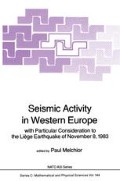Abstract
The seismotectonic activity of the Central European area between the Alps and the North Sea is controlled by two essential factors. The first is a wide-spread regional stress field within the Earth’s crust characterized by a rather uniform trend of the maximum compressive stress in NW-SE direction (145° with respect to North). The second controlling factor is the post-Hercynian block mosaic and the existence of deep reaching major fault structures like the Rhine Graben System which form distinct zones of crustal weakness. Under the influence of the large-scale stress field characteristic seismotectonic block movements are going on along pre-existing zones of crustal weakness which can be described by a rather simple deformation model.
The focal mechanism of the Liege earthquake on November 8, 1983, fits well to the large-scale deformation model. The fault plane solution elaborated on the basis of P wave first motions of 65 seismic stations in Central Europe reveals a prevailing strike-slip dislocation combined with a small thrust component. The fault movement is either right-lateral along a WSW-ENE trending plane, or left-lateral along a NNW-SSE trending plane. From geological evidence it is assumed that the WSW-ENE plane is the true rupture plane. The pressure axis is orientated NW-SE and nearly horizontal.
The unusual high stress drop of the Liège mainshock of approximately 156 bar as estimated from S wave spectra points to comparatively high crustal stresses at shallow depth in the northwestern border region of the Rhenish Massif. This is in agreement with the results of a hydraulic fracturing experiment in the research borehole Konzen 1 (near Monschau, 50 km SE of Liege), where a maximum shear stress of 38 bar has been found at a depth of 400 m with increasing tendency to greater depth.
Access this chapter
Tax calculation will be finalised at checkout
Purchases are for personal use only
Preview
Unable to display preview. Download preview PDF.
References
Ahorner, L. (1970): Seismotectonic relations between the graben zones of the Upper and Lower Rhine valley. - In: H.J.Illies & St. Müller (eds.), Graben Problems, p. 155–166; Schweizerbart, Stuttgart
Ahorner, L. (1975): Present-day stress field and seismotectonic block movements along major fault zones in Central Europe. — Tectonophysics 29: 233–249; Amsterdam
Ahorner, L. (1983): Historical seismicity and present-day microearthquake activity of the Rhenish Massif, Central Europe. — In: K. Fuchs et al.(eds), Plateau Uplift, p. 198–221; Springer, Heidelberg
Ahorner, L., Baier, B., and Bonjer, K.P. (1983): General pattern of seismotectonic dislocation and the earthquake generating stress field in Central Europe between the Alps and the North Sea. — In: K.Fuchs et al.(eds.), Plateau Uplift, p. 187–197; Springer, Heidelberg
Ahorner, L., Murawski, H. and Schneider, G. (1972): Seismotektonische Traverse von der Nordsee bis zum Apennin. - Geol.Rdsch. 61: 915–942; Stuttgart
Ahorner, L. and Pelzing, R. (1985): The source characteristics of the Liège earthquake on November 8, 1983, from digital recordings in West Germany. — (this volume)
Baumann, H. and lilies, H.J. (1983): Stress field and strain release in the Rhenish Massif. — In: K.Fuchs et al. (eds.), Plateau Uplift, p. 177–186; Springer, Heidelberg
Bonjer, K.P. (1979): The seismicity of the Upper Rhine Graben. A continental rift system. — In: Petrovski, J. and Allen, C. ( eds. ), Proc.Int.Res.Conf.Intra-Continental Earthquakes Ohrid/Yugoslavia 1979, p. 107–115
De Becker, M. and Camelbeeck, T. (1985): Macroseismic inquiry of the Liège earthquakes on November 8, 1983. — (this volume)
Fourmarier, P. (1954): Prodrome d’une description géologique de la Belgique. — 826 p.; Liège
Gils van, J.-M. and Zaczek, Y. (1978): La séismicité de la Belgique et son application en génie paraseismique. — Ann.Trav.Publ.Belg. 6: 1–38; Bruxelles
Fuchs, K., von Gehlen, K., Malzer, H., Murawski, H. and Semmel, A. (I983)(eds.), Plateau Uplift, 411 p.; Springer, Heidelberg
Illies, H.J. and Greiner, G. (1979): Holocene movements and the state of stress in the Rhine graben rift system. — Tectonophysics 52: 349–359; Amsterdam
Liu, Han-Shou (1983): A dynamical basis for crustal deformation and seismotectonic block movements in Central Europe. — Phys. Earth Planet.Inter. 32: 146–159; Amsterdam
Malzer, H., Hein, G. and Zippelt, K. (1983): Height changes in the Rhenish Massif: Determination and analysis. — In: K. Fuchs et al. (eds.), Plateau Uplift, p. 164–176; Springer, Heidelberg
Pavoni, N. and Mayer-Rosa, D. (1978): Seismotektonische Karte der Schweiz 1:750 000. — Eclogae geol.Helv. 71/2: 293–295; Basel
Ritsema, A.R. (1968): Seismo-tectonic implications of a review of European erathquake mechanisms. — Geol.Rdsch. 59: 36–56; Stuttgart
Rummel, F. and Baumgartner, J. (1985): Hydraulic fracturing in-situ Spannungsmessungen in der 400 m tiefen Erkundungsbohrung Nordeifel (Hohes Venn). — im Druck
Schneider, G. (1968): Erdbeben und Tektonik in Südwest-Deutschland. — Tectonophysics 5: 459–511; Amsterdam
Author information
Authors and Affiliations
Editor information
Editors and Affiliations
Rights and permissions
Copyright information
© 1985 D. Reidel Publishing Company
About this chapter
Cite this chapter
Ahorner, L. (1985). The General Pattern of Seismotectonic Dislocations in Central Europe as the Background for the Liège Earthquake on November 8, 1983. In: Melchior, P.J. (eds) Seismic Activity in Western Europe. NATO ASI Series, vol 144. Springer, Dordrecht. https://doi.org/10.1007/978-94-009-5273-7_4
Download citation
DOI: https://doi.org/10.1007/978-94-009-5273-7_4
Publisher Name: Springer, Dordrecht
Print ISBN: 978-94-010-8829-9
Online ISBN: 978-94-009-5273-7
eBook Packages: Springer Book Archive

